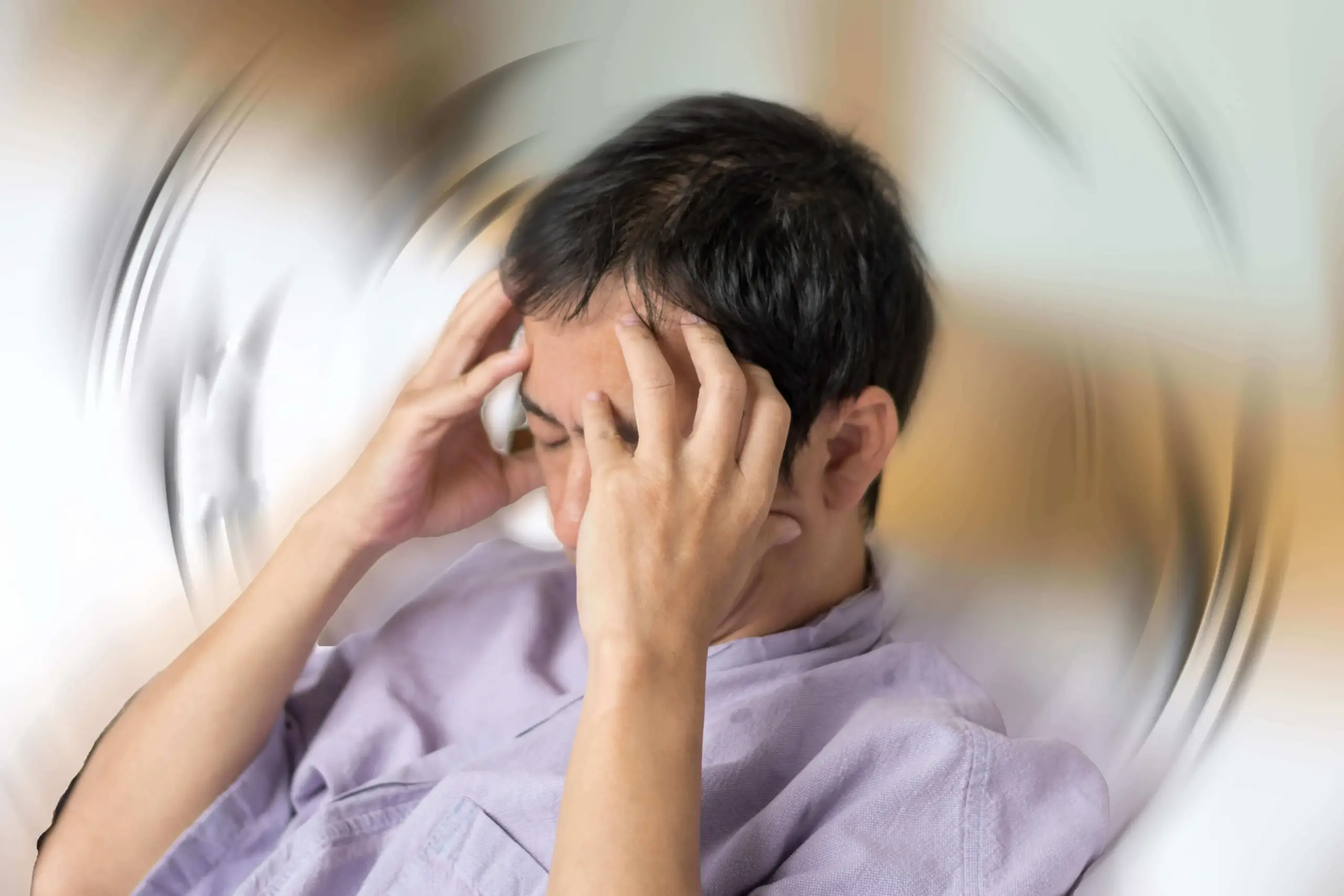What is a basilar migraine?
Basilar migraine is an older term for what is now called migraine with brainstem aura. It is an uncommon type of migraine attack, which has previously also been called basilar artery migraine and brainstem migraine. Similar to any migraine, it is an electrical event in the brain, but is associated with a variety of concerning neurological symptoms including vertigo. The symptoms associated with a basilar migraine are thought to originate from electrical dysfunction in the brainstem.
The disorienting sensations of vertigo and disequilibrium, intertwined with other neurological symptoms and a throbbing headache paints a vivid picture of a basilar migraine.
What’s the difference between vestibular migraine and basilar migraine?
Vestibular migraine is another form of migraine associated with vertigo and dizziness type symptoms, and is discussed in a separate blog. However, there are usually clear clinical differences because basilar migraine is more severe and associated with additional neurological symptoms besides just vertigo.
Understanding Basilar Migraines
A basilar migraine is like a puzzle, with pieces that don’t seem to fit at first glance. Originating from the brainstem, this migraine type is distinct in its presentation. While most migraines are known for their painful headaches, the basilar variety adds a twist to vertigo’s dizzying effects. It’s not just a headache; it’s a multi-sensory experience that can be both baffling and overwhelming.
The older terms such as basilar migraine were derived from the older vascular theory of migraine which theorized that these symptoms were due to narrowing and spasm of the basilar artery which travels along the back of the brainstem. It was suspected that this led to a lack of blood flow (ischemia) to the brainstem, causing the neurologic symptoms. However, we now know that migraine is primarily an electrical event. So it is now theorized that these neurologic symptoms such as vertigo and dizziness are from electrical dysfunction in the brainstem associated with hypometabolism of the brainstem neurons. Like regular migraine aura, hypometabolism can be associated with decreased blood flow to that area of brain tissue because the underactive neurons are not requiring as much blood flow, rather than a true lack of blood flow (ischemia).
Symptoms of Basilar Migraines
When a basilar migraine strikes, it’s like a symphony of symptoms, each playing its part:
- Vertigo: Often the star of the show. It’s a sensation that the world is spinning or tilting, even when you’re perfectly still. It can be disorienting, making simple tasks seem Herculean. Vertigo doesn’t necessarily mean basilar migraine though. Vertigo and migraine can also occur with vestibular migraine. One main way to differentiate these two is that the vertigo associated with basilar migraine MUST be combined with aura (not a requirement for vestibular migraine), in addition to at least one additional reversible brainstem symptom as listed below. With all of that said, although vertigo is one of the more common brainstem symptoms seen in basilar migraine, it doesn’t have to be present at all. The diagnosis requires at least two of the brainstem symptoms listed below, in addition to a migraine with aura.
- Aura: A common accompaniment to migraines, auras are sensory disturbances. They can manifest as flashing lights, blind spots, or even tingling sensations. The diagnosis of basilar migraine requires that the brainstem symptoms noted below occur in the setting of a migraine with aura.
- Other Brainstem Symptoms: The list doesn’t end there. In fact, the diagnosis requires at least two brainstem symptom. Besides the possibility of vertigo, some might experience tinnitus, a ringing in the ears, or dysarthria, where speech becomes slurred or slow. It’s a cocktail of symptoms that can vary from one episode to another. Decreased hearing (hypacusis), double vision (diplopia), unsteadiness and loss of balance (ataxia), and decreased level of consciousness are the additional symptoms that can occur during a basilar migraine.
The Intricate Link Between Vertigo and Headaches
Ever wondered how vertigo and headaches come together in the realm of a basilar migraine? It’s akin to two melodies harmonizing in a song. While at first glance, they might appear distinct, they’re intrinsically connected by their roots in the brainstem. The sensation of vertigo isn’t merely an arbitrary symptom; it emerges due to the migraine’s influence on the areas of the brain responsible for maintaining equilibrium. This intertwining of symptoms creates a complex experience that’s both intriguing to understand and intense for those enduring it.
Delving into the Origins and Catalysts
Pinpointing the exact genesis of a basilar migraine is not entirely known. However, the picture is becoming clearer with ongoing research and observations:
- Potential Causes: Outdated theories suggested that alterations in the basilar artery, a pivotal blood vessel in the brain, might be at the heart of these migraines. Older views suggested that there was spasm of the basilar artery and this led to lack of blood flow (ischemia) to the brain stem causing these stroke-like symptoms However, it is now felt that the cause of basilar migraines is actually electrical and not vascular at all. There can be some decreased blood perfusion to the affected area of the brain during aura symptoms as mentioned above, but it is not a lack of blood flow due to ischemia or blockage of a blood vessel.
- Identifiable Triggers: While the root cause might be elusive, the triggers that ignite a basilar migraine episode are more discernible. Everyday stressors, specific dietary choices, or even atmospheric changes like a drop in barometric pressure can be the spark. Recognizing and navigating these triggers becomes essential, acting as the first line of defense against the onset of these migraines. Genetic predispositions and shifts in hormonal balances can also contribute.
Treatment and Management
Tackling a basilar migraine requires a multi-faceted approach. While there’s no one-size-fits-all solution, there are several avenues to explore:
- Medications: Over-the-counter pain relievers might offer some relief, but for more persistent or severe episodes, prescription medications come into play. Depending on the individual’s symptoms and medical history, doctors might recommend specific migraine abortive medications such as the gepants (Nurtec, Ubrelvy, Zavspret), as well as preventive medications if the attacks are frequent enough. Triptans and DHE are still usually avoided when possible given theoretical potential for causing ischemia from vasoconstriction in an already decreased area of blood perfusion due to the neuronal hypometabolism.
- Alternative Therapies: Sometimes, relief lies outside the realm of conventional medicine. Techniques like acupuncture or biofeedback have shown promise for some. Natural supplements such as magnesium can be helpful in preventing attacks. Even simple relaxation exercises or meditation can make a difference, helping to ease the stress that often exacerbates symptoms.
- Lifestyle Adjustments: Recognizing and avoiding triggers is crucial. It might mean dietary changes, adopting a consistent sleep routine, or finding ways to manage daily stresses. Small changes can lead to significant relief.
Prevention and Coping Strategies
While we can’t put up an impenetrable shield against basilar migraines, we can certainly fortify our defenses:
- Awareness: Knowing the signs of an impending migraine can allow for early intervention, potentially reducing the severity or even warding it off. Studies have shown that early treatment during the migraine prodrome phase can cut the migraine attack severity in half.
- Routine: Consistency, be it in sleep, diet, or daily activities, can be a deterrent for migraines. The body thrives on routine.
- Relaxation Techniques: Stress is a notorious migraine trigger. Embracing relaxation techniques, whether it’s deep breathing, yoga, or even a leisurely walk, can keep stress at bay.
A Note from Virtual Headache Specialist
Navigating the maze of basilar migraines can be daunting. But remember, every maze has an exit, and you’re not wandering alone. At Virtual Headache Specialists, we’re your guiding light. With our deep understanding of migraines, we’re dedicated to helping you find your way out. It’s not just about medications; it’s about crafting a holistic approach that resonates with your unique journey.
IF YOU HAVE HEADACHE, MIGRAINE, OR FACIAL PAIN AND ARE LOOKING FOR ANSWERS ON ANYTHING RELATED TO IT, A HEADACHE SPECIALIST IS HERE TO HELP, FOR FREE!
FIRST, LET’S DECIDE WHERE TO START:
IF YOU HAVE AN EXISTING HEADACHE, MIGRAINE, OR FACIAL PAIN DIAGNOSIS AND ARE LOOKING FOR THE LATEST INFORMATION, HOT TOPICS, AND TREATMENT TIPS, VISIT OUR FREE BLOG OF HOT TOPICS AND HEADACHE TIPS HERE. THIS IS WHERE I WRITE AND CONDENSE A BROAD VARIETY OF COMMON AND COMPLEX MIGRAINE AND HEADACHE RELATED TOPICS INTO THE IMPORTANT FACTS AND HIGHLIGHTS YOU NEED TO KNOW, ALONG WITH PROVIDING FIRST HAND CLINICAL EXPERIENCE FROM THE PERSPECTIVE OF A HEADACHE SPECIALIST.
IF YOU DON’T HAVE AN EXISTING HEADACHE, MIGRAINE, OR FACIAL PAIN DIAGNOSIS AND ARE LOOKING FOR POSSIBLE TYPES OF HEADACHES OR FACIAL PAINS BASED ON YOUR SYMPTOMS, USE THE FREE HEADACHE AND FACIAL PAIN SYMPTOM CHECKER TOOL DEVELOPED BY A HEADACHE SPECIALIST NEUROLOGIST HERE!
IF YOU HAVE AN EXISTING HEADACHE, MIGRAINE, OR FACIAL PAIN DIAGNOSIS AND ARE LOOKING FOR FURTHER EDUCATION AND SELF-RESEARCH ON YOUR DIAGNOSIS, VISIT OUR FREE EDUCATION CENTER HERE.


